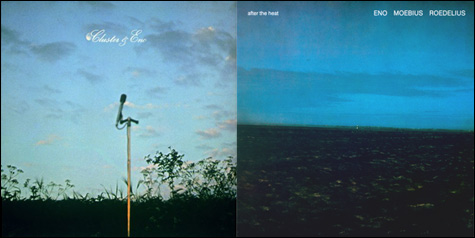 |
In April 1977, the notorious — and notoriously hip — German terrorists of the Baader-Meinhof Group were finally convicted for their revolutionary spree. In the fall of that year, the related Red Army Faction (later the subject of a celebrated musique concrète Eno B-side) conducted its “German Autumn” campaign, a high peak of political violence within the turbulence of the European ’70s. That nervous summer, sandwiched between those landmarks of agitation, Brian Eno sequestered himself with Moebius and Roedelius (a/k/a Kluster or Cluster) in Conny Plank’s farmhouse studio near Cologne and recorded Cluster & Eno, a series of repetitive jams anchored by keyboards and sequencers. The krautrock pioneers proved much more simpático musical partners than either the fractious Roxy Music or the British classical avant-garde milieu that thought of Eno as an untrained fanboy. Über-producer Plank and his instrumentalists gave the inquisitive “non-musician” a physical and mental place to experiment, relax, and groove to everything from Fela Kuti and Lee “Scratch” Perry to Tristan Tzara and Chopin. “Wehrmut” sounds in hindsight like the logical conclusion of Eno’s earlier ambient experiments; the unabashed Orientalism of “One” elaborates on his peculiar take on psychedelia — George Harrison’s “Love You To” mutated into a chillout mix and progressing into dark weirdness. A year later, the musicians reconvened and produced After the Heat, their greatest collaboration. The bass-heavy, synth-drenched instrumentals show how inventive film scores could have become if John Williams had never been born. And the final three tracks constitute a tour de force Eno EP, one deeply connected to Another Green World and Before and After Science. The relentless chanting of “Broken Head” — with its “son of ‘Sky Saw’ ” malevolent fuzzlines — unveils a whole Beckett play in five minutes; that’s followed by “The Belldog,” one of the most gorgeous examples of the inimitable Enoballad. This de facto mini-suite closes with the loops and backwards chanting of “Tzima N’arki,” bringing it all back to the home of Dada.